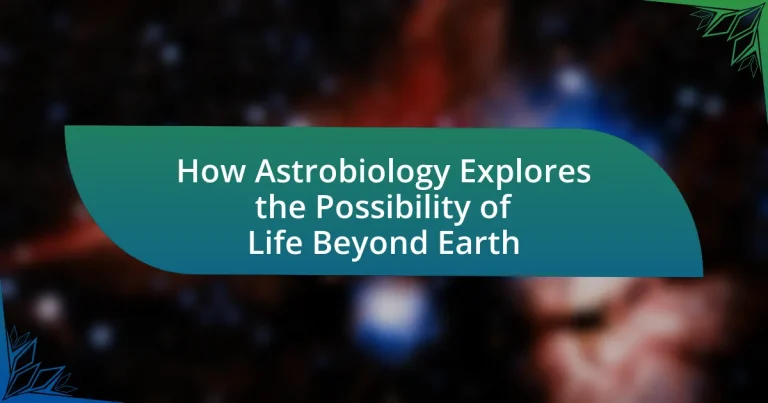Astrobiology is the scientific study of the origin, evolution, distribution, and future of life in the universe, with a particular focus on the potential for life beyond Earth. This interdisciplinary field integrates biology, chemistry, geology, and astronomy to explore environments that may support life, such as Mars and the icy moons of Jupiter and Saturn. The article outlines the methods astrobiologists use to search for extraterrestrial life, the significance of exoplanets, and the implications of discovering life beyond Earth. It also discusses the challenges faced in astrobiological research, including funding limitations and ethical considerations, while highlighting the importance of citizen science and educational resources for engaging with the field.

What is Astrobiology and its Role in Exploring Life Beyond Earth?
Astrobiology is the scientific study of the origin, evolution, distribution, and future of life in the universe, focusing on the potential for life beyond Earth. This interdisciplinary field combines aspects of biology, chemistry, geology, and astronomy to understand the conditions that might support life on other planets and moons. Astrobiology plays a crucial role in exploring life beyond Earth by guiding missions to celestial bodies, such as Mars and Europa, where scientists search for signs of past or present life. For instance, the Mars rover missions have provided evidence of ancient water, which is essential for life, thereby supporting astrobiological hypotheses.
How does Astrobiology define the search for extraterrestrial life?
Astrobiology defines the search for extraterrestrial life as the scientific investigation of the origins, evolution, distribution, and future of life in the universe. This field combines aspects of biology, chemistry, geology, and astronomy to explore environments beyond Earth that may harbor life, such as Mars, Europa, and exoplanets. Astrobiologists utilize methods like analyzing extreme environments on Earth, studying the chemical building blocks of life, and searching for biosignatures in the atmospheres of distant planets to validate their hypotheses about life beyond our planet.
What are the key principles of Astrobiology?
The key principles of Astrobiology include the study of the origin, evolution, distribution, and future of life in the universe. This interdisciplinary field combines aspects of biology, chemistry, geology, and astronomy to understand how life might arise elsewhere in the cosmos. For instance, the principle of habitability focuses on identifying environments that could support life, such as those with liquid water, essential nutrients, and energy sources. Additionally, the concept of extremophiles—organisms that thrive in extreme conditions on Earth—provides insights into the potential for life in harsh extraterrestrial environments. Research has shown that life can exist in extreme temperatures, pressures, and radiation levels, suggesting that similar life forms could exist on other planets or moons.
How does Astrobiology differ from other scientific fields?
Astrobiology differs from other scientific fields by specifically focusing on the study of life in the universe, including the origins, evolution, and potential existence of extraterrestrial life. Unlike traditional biology, which primarily examines life on Earth, astrobiology integrates disciplines such as astronomy, planetary science, and geology to explore environments beyond our planet that may support life. For instance, astrobiologists investigate extreme conditions on Earth, such as hydrothermal vents and acidic lakes, to understand how life might survive on planets like Mars or moons like Europa. This interdisciplinary approach is unique to astrobiology, as it combines knowledge from various scientific domains to address questions about life beyond Earth.
Why is the study of life beyond Earth important?
The study of life beyond Earth is important because it expands our understanding of biology, evolution, and the potential for life in the universe. This exploration can reveal whether life exists elsewhere, which has profound implications for our knowledge of life’s origins and the conditions necessary for life to thrive. For instance, the discovery of extremophiles on Earth, organisms that survive in extreme conditions, suggests that life could exist in diverse environments, such as on Mars or the icy moons of Jupiter and Saturn. Additionally, missions like the Mars rovers and the study of exoplanets contribute to this understanding by providing data on planetary conditions that may support life.
What implications does discovering extraterrestrial life have for humanity?
Discovering extraterrestrial life would fundamentally alter humanity’s understanding of its place in the universe. This revelation could lead to profound philosophical, scientific, and sociopolitical implications, as it challenges the uniqueness of human existence and prompts reevaluation of religious and existential beliefs. For instance, the discovery of microbial life on Mars or in the subsurface oceans of Europa would suggest that life can arise in diverse environments, supporting theories of panspermia and expanding the search for habitable worlds. Furthermore, it could foster international collaboration in space exploration and astrobiology, as nations unite to study and understand the implications of such a discovery. The potential for communication with intelligent extraterrestrial civilizations could also raise ethical questions regarding contact protocols and the impact on global society.
How can Astrobiology inform our understanding of life on Earth?
Astrobiology can inform our understanding of life on Earth by providing insights into the origins, evolution, and potential diversity of life in various environments. By studying extreme environments on Earth, such as hydrothermal vents and acidic lakes, astrobiologists can identify the biochemical pathways that support life, which may also exist on other planets. Research has shown that organisms in these extreme conditions share fundamental biological processes, suggesting that life could adapt to similar environments elsewhere in the universe. For example, the discovery of extremophiles, like the bacterium Deinococcus radiodurans, demonstrates the resilience of life, indicating that life could potentially thrive on planets with harsh conditions, such as Mars or Europa. This understanding enhances our knowledge of life’s adaptability and informs the search for extraterrestrial life.

What methods do Astrobiologists use to search for life beyond Earth?
Astrobiologists use a variety of methods to search for life beyond Earth, including remote sensing, robotic exploration, and laboratory simulations. Remote sensing involves analyzing data from telescopes and spacecraft to detect biosignatures in the atmospheres of exoplanets, such as the presence of oxygen or methane, which may indicate biological activity. Robotic exploration includes missions like Mars rovers, which analyze soil and rock samples for organic compounds and microbial life. Laboratory simulations recreate extraterrestrial environments to study how life might survive under different conditions, providing insights into potential habitats beyond Earth. These methods are supported by findings from missions like the Kepler Space Telescope, which has identified thousands of exoplanets, and the Mars Curiosity Rover, which has discovered organic molecules on Mars, reinforcing the search for extraterrestrial life.
How do scientists identify potentially habitable environments?
Scientists identify potentially habitable environments by analyzing factors such as temperature, presence of liquid water, chemical composition, and energy sources. These criteria are essential because they determine whether conditions can support life as we know it. For instance, the discovery of liquid water on Mars and the subsurface oceans of Europa and Enceladus indicates environments where life could potentially exist. Additionally, scientists utilize remote sensing techniques to assess exoplanets’ atmospheres for biosignatures, which are indicators of biological activity. This method has led to the identification of several exoplanets within the habitable zone of their stars, where conditions may be suitable for life.
What criteria define a habitable zone around a star?
A habitable zone around a star is defined by the region where conditions allow for liquid water to exist on a planet’s surface. This zone is primarily determined by the star’s luminosity and temperature, which influence the distance at which a planet can maintain temperatures conducive to liquid water. For example, the habitable zone for a sun-like star typically ranges from about 0.95 to 1.37 astronomical units (AU) from the star, where Earth is located at 1 AU. The criteria also include the planet’s atmosphere, which must be capable of supporting life by retaining heat and providing essential gases. Research indicates that planets within this zone, such as those discovered in the Kepler mission, have the potential to support life, reinforcing the importance of these criteria in astrobiology.
How do extremophiles on Earth inform the search for life elsewhere?
Extremophiles on Earth inform the search for life elsewhere by demonstrating that life can thrive in extreme conditions previously thought to be inhospitable. These organisms, such as thermophiles found in hydrothermal vents and halophiles in salt flats, reveal that life can exist in environments with high radiation, extreme temperatures, or high salinity. For instance, the discovery of microorganisms in the acidic hot springs of Yellowstone National Park shows that life can endure temperatures exceeding 90 degrees Celsius. This adaptability suggests that similar life forms could potentially exist on other planets or moons with extreme environments, such as the subsurface oceans of Europa or the high-radiation surface of Mars. The study of extremophiles thus expands the potential habitats for extraterrestrial life, guiding astrobiological research and exploration missions.
What technologies are employed in Astrobiological research?
Astrobiological research employs a variety of technologies, including remote sensing, spectroscopy, and robotic exploration. Remote sensing technologies, such as satellites and telescopes, allow scientists to gather data about celestial bodies and their atmospheres from a distance. Spectroscopy is utilized to analyze the chemical composition of planetary atmospheres and surfaces, providing insights into potential biosignatures. Robotic exploration, through missions like Mars rovers and landers, enables direct investigation of extraterrestrial environments, facilitating the search for life. These technologies collectively enhance our understanding of the conditions necessary for life and the potential for its existence beyond Earth.
How do telescopes and space missions contribute to Astrobiology?
Telescopes and space missions significantly contribute to astrobiology by enabling the detection and analysis of exoplanets and their atmospheres, which are crucial for assessing the potential for life beyond Earth. For instance, the Kepler Space Telescope has identified thousands of exoplanets, some located in the habitable zone where conditions may support liquid water, a key ingredient for life. Additionally, missions like the Mars rovers have provided direct evidence of past water and organic molecules on Mars, supporting the hypothesis that life may have existed there. These observations and data collection efforts are essential for understanding the environments that could harbor life, thus advancing the field of astrobiology.
What role do robotic missions play in exploring other planets?
Robotic missions are essential for exploring other planets as they enable the collection of data and samples without the risks associated with human presence. These missions, such as NASA’s Mars rovers and the Voyager spacecraft, are equipped with advanced instruments that analyze planetary atmospheres, surface compositions, and potential biosignatures. For instance, the Mars Curiosity rover has provided critical insights into the planet’s geology and climate, revealing evidence of past water, which is vital for understanding the potential for life. Additionally, robotic missions can operate in extreme environments and cover vast distances, allowing for extensive exploration that would be impractical for human crews.

What are the current findings and theories in Astrobiology?
Current findings in astrobiology suggest that extremophiles, organisms that thrive in extreme environments on Earth, indicate that life could exist in similar conditions elsewhere in the universe, such as on Mars or the icy moons of Jupiter and Saturn. Theories propose that microbial life may survive in subsurface oceans, as evidenced by the discovery of liquid water beneath the surface of Europa and Enceladus. Additionally, the detection of organic molecules in the atmospheres of exoplanets, such as those found by the James Webb Space Telescope, supports the hypothesis that life-sustaining conditions may be more common than previously thought. These findings are reinforced by ongoing research, including studies published in journals like Nature Astronomy, which detail the potential habitability of celestial bodies based on their geological and atmospheric characteristics.
What discoveries have been made regarding Mars and its potential for life?
Recent discoveries indicate that Mars has conditions that may support microbial life. Evidence from NASA’s Curiosity rover has shown the presence of ancient riverbeds and lake sediments, suggesting that liquid water existed on the surface. Additionally, the detection of organic molecules and seasonal methane emissions raises the possibility of biological processes. The Mars 2020 Perseverance rover is currently exploring Jezero Crater, which was once a lake, to search for signs of past life and collect samples for future return to Earth. These findings collectively enhance the understanding of Mars as a potentially habitable environment in its ancient past.
What evidence supports the possibility of past life on Mars?
Evidence supporting the possibility of past life on Mars includes the discovery of ancient riverbeds, minerals that form in the presence of water, and organic molecules detected by the Curiosity rover. Ancient riverbeds indicate that liquid water once flowed on the Martian surface, creating a potentially habitable environment. Additionally, the presence of minerals like clays and sulfates suggests that water was abundant in Mars’ history. The Curiosity rover’s analysis revealed organic compounds, which are essential building blocks of life, further indicating that Mars may have had the necessary conditions for life to exist in the past.
How do current missions aim to uncover more about Martian life?
Current missions aim to uncover more about Martian life by utilizing advanced robotic technology to analyze the planet’s surface and atmosphere for signs of past or present life. For instance, NASA’s Perseverance rover is equipped with instruments designed to search for biosignatures and collect soil samples that may contain organic materials. Additionally, the Mars Sample Return mission, planned for the future, will bring these samples back to Earth for detailed analysis, enhancing our understanding of Mars’ potential to support life. These missions are grounded in astrobiological research, which seeks to identify the chemical and environmental conditions necessary for life, thereby providing concrete evidence of Mars’ habitability.
What is the significance of exoplanets in the search for extraterrestrial life?
Exoplanets are significant in the search for extraterrestrial life because they provide potential habitats outside our solar system where life could exist. The discovery of over 5,000 confirmed exoplanets, many located in the habitable zone of their stars, suggests that conditions suitable for life may be more common than previously thought. Research indicates that planets with Earth-like characteristics, such as size and temperature, increase the likelihood of hosting liquid water, a crucial ingredient for life. The Kepler Space Telescope’s findings have been instrumental in identifying these planets, demonstrating that a diverse range of planetary systems exists, which enhances the prospects for finding life beyond Earth.
How do scientists detect and analyze exoplanets?
Scientists detect and analyze exoplanets primarily through methods such as the transit method and radial velocity method. The transit method involves observing the dimming of a star’s light as a planet passes in front of it, allowing scientists to determine the planet’s size and orbital period. This technique has been successfully employed by missions like Kepler, which identified thousands of exoplanets by monitoring the brightness of over 150,000 stars.
The radial velocity method measures the star’s wobble caused by the gravitational pull of an orbiting planet, providing data on the planet’s mass and orbit. This method has been instrumental in confirming the existence of many exoplanets, including those in the habitable zone where conditions may support life.
Additionally, scientists utilize direct imaging and spectroscopy to analyze the atmospheres of exoplanets, searching for chemical signatures indicative of potential habitability. These techniques have led to the discovery of various exoplanets with atmospheres containing water vapor, carbon dioxide, and other molecules relevant to life.
What characteristics make certain exoplanets more likely to host life?
Certain exoplanets are more likely to host life if they possess characteristics such as being located in the habitable zone, having a stable atmosphere, and possessing liquid water. The habitable zone, often referred to as the “Goldilocks zone,” is the region around a star where conditions are just right for liquid water to exist, which is essential for life as we know it. A stable atmosphere can protect potential life forms from harmful radiation and help regulate temperature, while the presence of liquid water is crucial for biochemical processes. Research has shown that exoplanets like Kepler-186f and Proxima Centauri b exhibit these characteristics, making them prime candidates for hosting life.
What challenges does Astrobiology face in its research?
Astrobiology faces significant challenges in its research, primarily due to the difficulty of obtaining empirical data from extraterrestrial environments. The vast distances involved in space exploration limit direct observation and sample collection, making it challenging to study potential life forms on other planets or moons. For instance, missions to Mars and the icy moons of Jupiter and Saturn require advanced technology and substantial funding, which can be difficult to secure. Additionally, the lack of a clear definition of life complicates the identification of biosignatures, as scientists must determine what constitutes evidence of life in diverse and extreme environments. These challenges are compounded by the need for interdisciplinary collaboration, as astrobiology intersects with fields such as geology, chemistry, and planetary science, necessitating a broad range of expertise to address complex questions about life’s potential beyond Earth.
How do funding and resource limitations impact Astrobiological studies?
Funding and resource limitations significantly hinder astrobiological studies by restricting research capabilities and technological advancements. Limited financial support results in fewer missions to explore celestial bodies, which are crucial for gathering data on potential extraterrestrial life. For instance, NASA’s budget constraints have led to the postponement of missions like the Mars Sample Return, which is essential for understanding the planet’s habitability. Additionally, insufficient resources can limit the development of advanced instruments needed for detecting biosignatures, thereby impeding the progress of astrobiological research.
What ethical considerations arise in the search for extraterrestrial life?
The ethical considerations in the search for extraterrestrial life include the potential impact on discovered life forms, the implications of contamination, and the responsibilities of humanity in exploration. Firstly, if extraterrestrial life is found, ethical dilemmas arise regarding the treatment and rights of these beings, particularly if they exhibit intelligence or complex social structures. Secondly, the risk of contaminating other celestial bodies with Earth microbes raises concerns about preserving the integrity of those ecosystems, as highlighted by the Outer Space Treaty of 1967, which emphasizes the need for planetary protection. Lastly, the motivations behind the search, such as scientific curiosity versus exploitation, necessitate a careful ethical framework to ensure that exploration is conducted responsibly and with respect for potential extraterrestrial entities.
What practical steps can individuals take to engage with Astrobiology?
Individuals can engage with Astrobiology by pursuing education in relevant fields such as biology, chemistry, and astronomy. This foundational knowledge is crucial, as Astrobiology integrates these disciplines to explore the potential for life beyond Earth. Participating in online courses or attending workshops focused on Astrobiology can enhance understanding and provide practical skills. Additionally, individuals can join local or online science clubs and organizations dedicated to space exploration and Astrobiology, fostering collaboration and networking opportunities. Engaging with scientific literature, including journals like “Astrobiology” and “International Journal of Astrobiology,” allows individuals to stay updated on current research and discoveries in the field. Volunteering for space-related projects or internships with organizations like NASA or the European Space Agency can provide hands-on experience and deepen involvement in Astrobiology.
How can one get involved in citizen science projects related to Astrobiology?
One can get involved in citizen science projects related to Astrobiology by participating in platforms such as Zooniverse, which hosts various projects focused on space and life sciences. These platforms allow individuals to contribute to data collection and analysis, such as classifying images from telescopes or analyzing samples from Mars missions. For example, the “Planet Hunters” project enables volunteers to identify exoplanets by examining light curves from stars. Engaging in these projects not only aids scientific research but also enhances public understanding of astrobiology and the search for extraterrestrial life.
What resources are available for learning more about Astrobiology?
Books, online courses, and scientific journals are key resources for learning about Astrobiology. Notable books include “Astrobiology: A Very Short Introduction” by David C. Catling, which provides a concise overview of the field. Online platforms like Coursera and edX offer courses such as “Astrobiology and the Search for Extraterrestrial Life,” allowing learners to engage with the subject matter interactively. Additionally, journals like “Astrobiology” and “International Journal of Astrobiology” publish peer-reviewed research, providing insights into current studies and discoveries in the field. These resources collectively support a comprehensive understanding of Astrobiology and its exploration of life beyond Earth.




